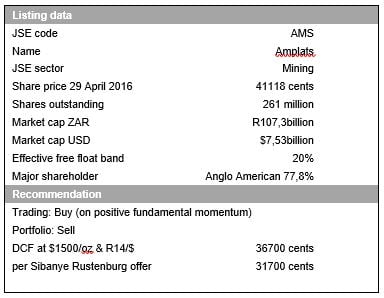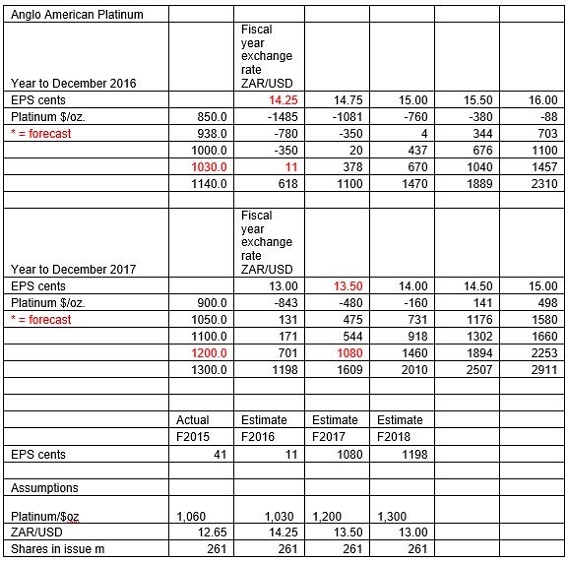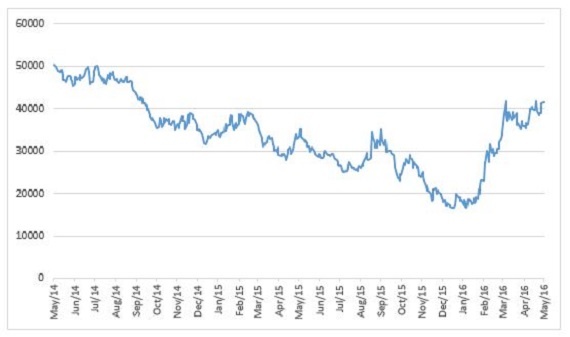Amplats

Amplats had a net after tax margin of only 0.18% or R107 million on revenue of R59,8 billion for the year ended December 2015. The exchange rate was R12,65/$ and the average price of platinum was $1,060/oz with palladium $696/oz and rhodium $952/oz. With such a small net margin, a small move in the currency or metal price will have a big effect on margin.
At a platinum price of $938/oz (the average for the year so far) and an exchange rate of R15,50/$ (the average for January through April) the net margin for Amplats is around 1.4% or R900 million. Although the platinum price is 11.5% lower than the average for 2015, the exchange rate is 18% weaker and thus more than offsets.
At the current spot price of $1,074/oz and an exchange rate of R14,20/$, the net margin at Amplats would be around 2.1%.
A 10% move up or down in the exchange rate (assuming this applies for a full year) has at least a 350% effect on earnings whereas a 10% move in the platinum price has a 200% effect on earnings.
Amplats has given 2016 production guidance at 2.35 million ounces at a cost of R19,500 per Pt/oz, which compares with a cost per Pt/oz of R22,070 in F2015. Revenue of around R29,000 per Pt/oz is feasible if current pricing trends prevail.
The calculation on platinum ounce strips out all PGM components other than platinum and excludes gold, nickel, copper and chrome. In 2015, of the refined PGM production of 4,87 million ounces platinum was 2,46 million ounces or 50.5%. As an example, given the production profile of Amplats sales revenue per Pt/oz sold of $2,000/oz would equate to a platinum price of approximately $1,000/oz.
Rustenburg, which produced 485 000 ounces in 2015, is being sold off to Sibanye. Therefore, around R12 billion of revenue will cease to be accounted by Amplats in 2017, offset by bought-in metals. Amandelbult and Mogalakwena will be the two largest mines at 460 000 ounces and 390 000 ounces apiece. Mogalakwena is at the lower end of the industry costs curve. Twickenham is on care and maintenance and under development as a mechanised operation and Union, Bokoni, Pandora and Kroondal are up for sale.
Given the variability of the revenue and profits drivers, arriving at a valuation is akin to picking points along a mile long ball of string.
The upfront payment of R1,5 billion that Sibanye paying for Rustenburg – together with 35% of future distributable free cash for six to eight years with a nominal R3 billion as a minimum - doesn’t inspire enthusiasm for value. If there is negative free cash then Amplats forks out R267 million per annum up to 2018. Sibanye is likely to capture much upside having limited the downside on the offer to Amplats.
On Amplats latest cash flow estimates for Rustenburg, estimated fair value of the total amount to be paid is R2,798 million and excludes concentrate and toll treatment.
The net carrying value of Rustenburg in September 2015 was R7,274 million and so the difference between R2,798 million and R7,274 million was cause for a gross impairment of R6,216 million or R4,476 million after tax.

At an exchange rate of R14/$ the price for Rustenburg is $320 million (assuming the R1,5 billion plus the R3 billion) which equates to $33/oz on a reserve basis and $3,60/oz on a resource basis. On the lesser amount of R2,798 million the reserve basis value is $20/oz.
The caveat by Sibanye of distributable free cash flows is smart. Cash flows in platinum miners are usually less than reported earnings due to depreciation on a historic cost basis understating real capex spend for sustainability.
The post-tax impairments of R14 billion at Amplats in 2015, of which R4,5 billion was Rustenburg, squares with this reality and a written down asset base also flatters return on equity. Total assets reduced by 17.8% in 2015 to R74 billion, with property, plant and equipment down 10% to R39,9 billion, and shareholder equity fell by 20.8% to R40,0 billion. It would take a lot more than R40 billion plus some debt funding and working capital to start Amplats from scratch today.
Excluding Rustenburg, Amplats has South African and Zimbabwean ore reserves of 175 million ounces and resources of 827 million ounces.
On the basis of the Sibanye deal, excluding any future free cash and based on the headline value of R4,5 billion, then Amplats on a proportionate basis in relation to reserves is worth $5,8 billion. This is R82,7 billion or R317 per share at R14,25/$.
Remaining Amplats assets have future development plans and give optionality to the share price, as does the future potential profitability over and above what Sibanye has based its offer.
On a DCF basis, assuming platinum at $1,500/oz and a rand at R14/$, then an enterprise value of approximately R400 per share is defendable. There is debt of R12,8 billion or R49/share, which on future cash flow projections could fall to R8,5 billion or R33/share in 2016.
This leaves residual value of R367/share or an equity value of R96 billion – within 15% of the Sibanye ore reserve value assumption.
My updated estimates follow and predicated on conservative assumptions. Earnings per share outcomes are at differing currency and platinum price points.
Estimates for Amplats - EPS on differing platinum and currency assumptions
Source: company and MN Ingham

Amplats share price in ZA cents
